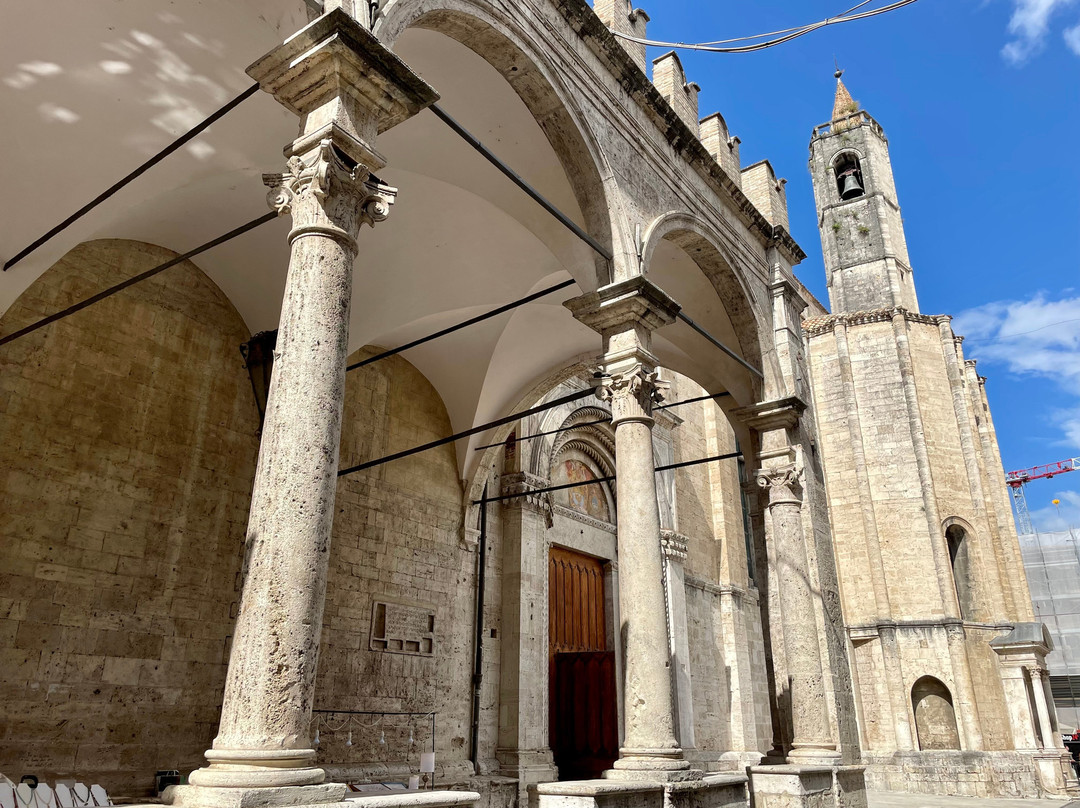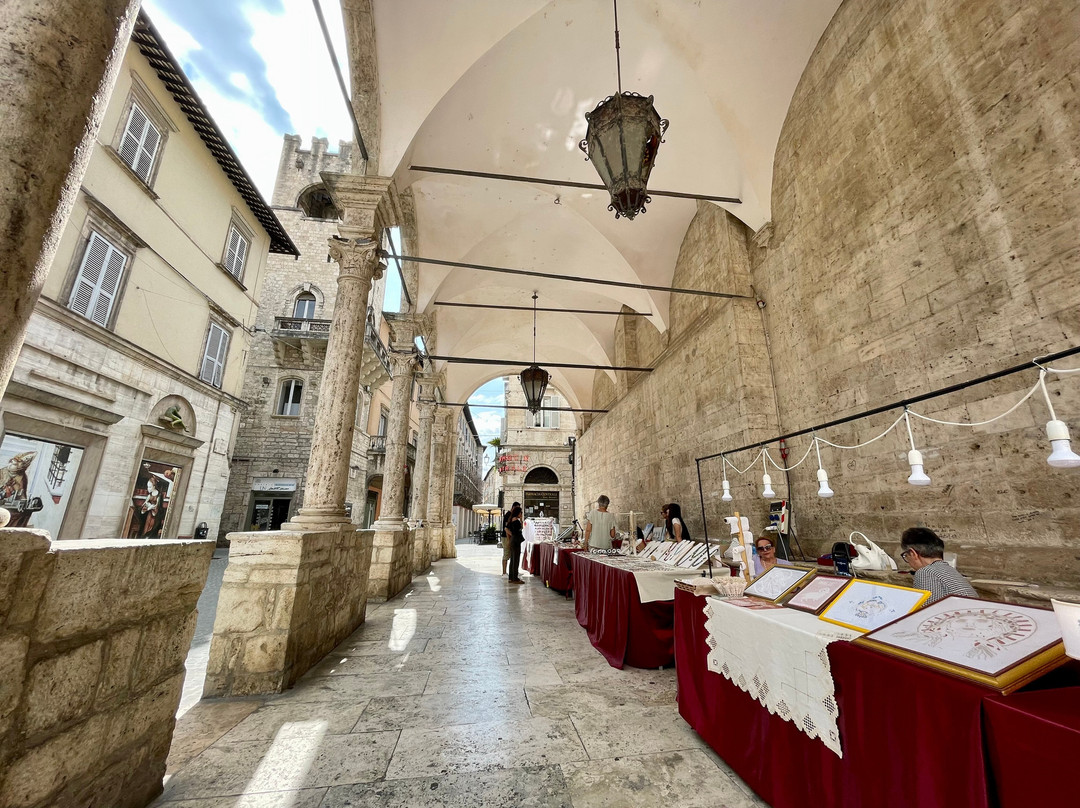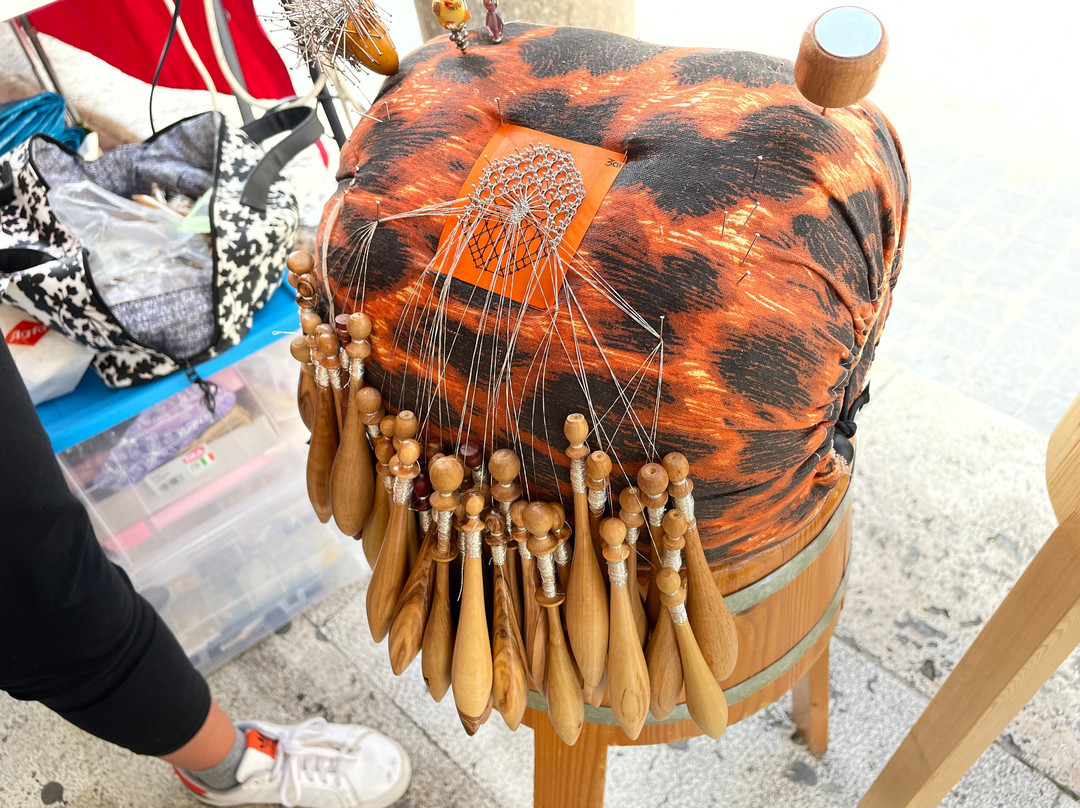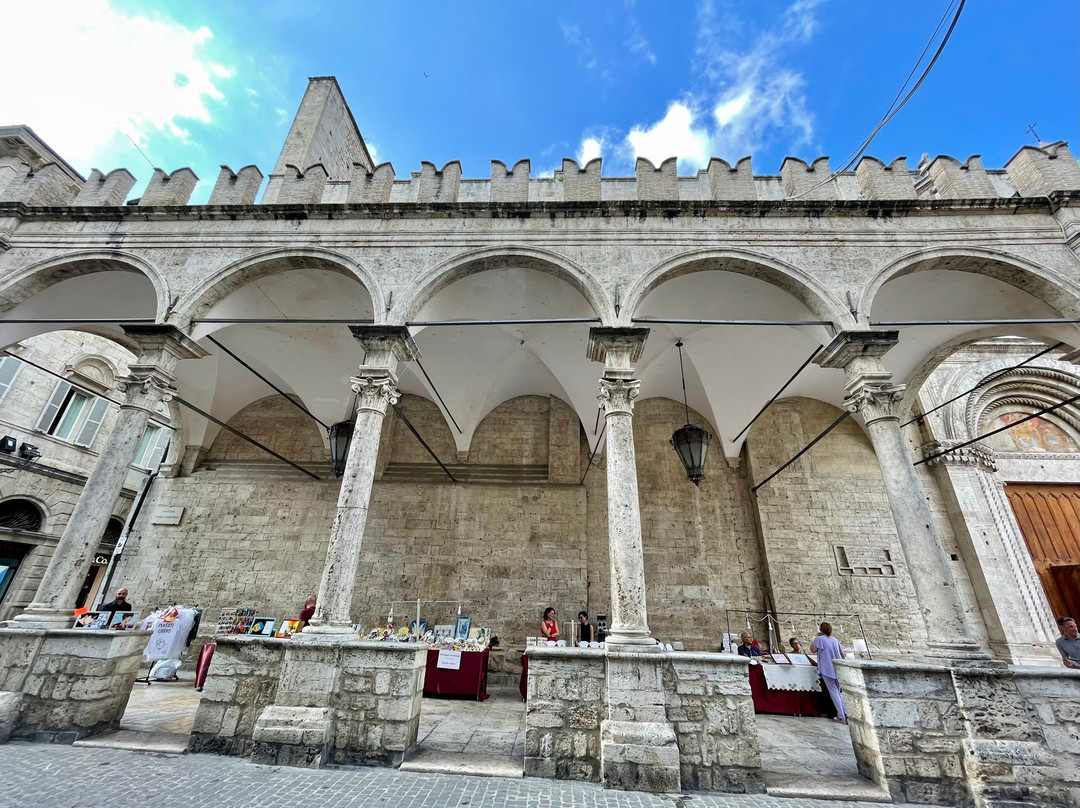的点评
Weekend Market Under the Arches
Loggia dei Mercanti的点评
点评:The Loggia dei Mercanti is one of the historic sights on Piazza del Popolo. This is long, verandah-like structure was built in the 16th century by the powerful and wealthy wool merchants’ guild. It consists of five wide arches, supported by columns that sit on high, solid stone cubes. Buying and selling of wool took place under the arches.
The structure is annexed to the Gothic Church of St Francis, and runs along the side of the church, fronting onto the piazza.
It struck us as a bit incongruous to have a place of common trade and business stuck like a barnacle on the side of the church but business, politics and religion was much more interrelated in the past and wool and textiles were big business. The wool merchants had also helped fund the construction of the church and when we walked around to the main door, we spotted a relief sculpture of a lamb, symbol of the wool merchants, decorating the tympanum above the main entrance.
A small craft market was being held under the arches when we were (it was a weekend). We stopped for some time watching a woman make fine lace using traditional techniques. She was amazingly adept at manipulating the bobbins to braid and twist the multiple threads and she patiently described a little of what she does.
The structure is annexed to the Gothic Church of St Francis, and runs along the side of the church, fronting onto the piazza.
It struck us as a bit incongruous to have a place of common trade and business stuck like a barnacle on the side of the church but business, politics and religion was much more interrelated in the past and wool and textiles were big business. The wool merchants had also helped fund the construction of the church and when we walked around to the main door, we spotted a relief sculpture of a lamb, symbol of the wool merchants, decorating the tympanum above the main entrance.
A small craft market was being held under the arches when we were (it was a weekend). We stopped for some time watching a woman make fine lace using traditional techniques. She was amazingly adept at manipulating the bobbins to braid and twist the multiple threads and she patiently described a little of what she does.
翻译:商人长廊是人民广场上的历史景点之一。这座长长的、类似阳台的建筑是由强大而富有的羊毛商人行会于 16 世纪建造的。它由五个宽阔的拱门组成,由高耸的坚固石立方体上的柱子支撑。羊毛的买卖是在拱门下进行的。
该建筑附属于哥特式圣弗朗西斯教堂,沿着教堂的一侧延伸,面向广场。
在我们看来,在教堂的一侧像藤壶一样卡着一个共同的贸易和商业场所有点不协调,但商业、政治和宗教在过去的相互联系要紧密得多,而羊毛和纺织品是大生意。羊毛商人也资助了教堂的建设,当我们走到正门时,我们发现了一只羔羊的浮雕,它是羊毛商人的象征,装饰在正门上方的鼓室上。
我们去的时候(当时是周末),拱门下正在举办一个小型工艺品市场。我们停下来观察了一位女士用传统技术制作精美的蕾丝。她非常擅长操纵线轴来编织和扭转多根线,并且她耐心地描述了一些她所做的事情。
该建筑附属于哥特式圣弗朗西斯教堂,沿着教堂的一侧延伸,面向广场。
在我们看来,在教堂的一侧像藤壶一样卡着一个共同的贸易和商业场所有点不协调,但商业、政治和宗教在过去的相互联系要紧密得多,而羊毛和纺织品是大生意。羊毛商人也资助了教堂的建设,当我们走到正门时,我们发现了一只羔羊的浮雕,它是羊毛商人的象征,装饰在正门上方的鼓室上。
我们去的时候(当时是周末),拱门下正在举办一个小型工艺品市场。我们停下来观察了一位女士用传统技术制作精美的蕾丝。她非常擅长操纵线轴来编织和扭转多根线,并且她耐心地描述了一些她所做的事情。




此点评仅代表旅行者个人的主观意见,并不代表TripAdvisor以及其合作方的意见。
关于我们
|新闻动态
|商务合作
|会员中心
|业主中心
|常见问题
|意见反馈
|联系我们
|营业执照
© 2025 Tripadvisor 版权所有。
使用条款 |隐私政策 |网站工作原理
部分照片由 VFM Leonardo 提供。
* Tripadvisor不是旅行社,也不是旅游预订服务代理商。我们提供免费、客观、公正的旅游资讯服务。 (显示更多)
TripAdvisor LLC 既不是预订代理商,也不是旅游运营商,不会向网站用户收取任何服务费。 按照规定,在 Tripadvisor 发布机票价格、游览和旅行套餐的合作伙伴(航空公司、旅行提供商及预订代理商),其标价须包含所有费用和附加费用。 例如, 机场出入境税费、消费税与其他服务费、手续费、杂费及附加费用。 当您向我们的某个合作伙伴进行预订时,请务必查阅他们的网站以了解当地行政部门要求的所有适用费用的具体情况。 除非另有说明,机票价格通常指的是一个人的价格(以人民币计)。
为方便起见,TripAdvisor LLC 根据从我们的预订合作伙伴获取的空房率计算每个酒店的均价。 对于游览和景点来说,所显示价格通常是每位成人的最低可用价格。 对于列出的任何旅行套餐或优惠,TripAdvisor LLC 无法保证任何特定的费率或价格。 此外,酒店均价每晚会更新,并以您的首选币种表示(使用现行汇率)。 由于这些已换算的价格是预估价格,因此,有关具体金额和币种请与预订网站进行核实。
此外,TripAdvisor LLC 无法保证我们网站上宣传的价格随时有效。 标价可能需要预订一定天数才能生效,或有不可用日期、使用条件或限制。
TripAdvisor公司对外部网站的内容一概不负责。优惠价格中不含税和其他费用。
ICP证:沪B2-20200433
沪ICP备20013175号
 沪公网安备31010502005427号
沪公网安备31010502005427号鹰程信息技术(上海)有限公司
货币/国家及地区
¥CNY
中国

